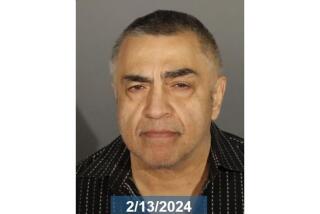Suit Claims Conspiracy in Fatal Overdose
- Share via
A Westside psychiatrist, a celebrity private detective, a top Hollywood producer and more than a dozen others conspired to cover up the circumstances surrounding the drug overdose of a doctor who died last year at filmmaker Don Simpson’s Bel-Air home, a lawsuit filed Wednesday contends.
The 48-page wrongful death complaint, filed in Los Angeles County Superior Court by the father and son of Dr. Stephen W. Ammerman, alleges that evidence was destroyed and Ammerman’s body was moved after his death to keep police from discovering an elaborate and illegal drug detoxification program Simpson was undergoing. The suit contends that a series of actions by Simpson and others contributed to Ammerman’s death.
“The conduct of the defendants in this case--some who are among the most powerful principals in the entertainment industry--was outrageous and despicable,” said Alexander R. Lampone, a physician and attorney retained by the Ammerman family.
Ammerman, 44, died of a drug overdose one year ago today at Simpson’s Bel-Air estate. Simpson, 52, was found dead of an overdose on the same property five months later.
The two deaths spurred a criminal probe into prescription drug abuse by local doctors and pharmacies. No charges have been brought as a result of the investigation, which is continuing.
The civil lawsuit, which seeks $50 million in damages, names 19 defendants, including Simpson’s former partner Jerry Bruckheimer, Los Angeles private detective Anthony Pellicano, Simpson’s estate, Simpson’s brother Lary Simpson, Prime Care Pharmacy in Van Nuys and psychiatrist Dr. Nomi J. Fredrick, who prescribed drugs to Simpson and Ammerman.
Pellicano denied the allegations. A representative for Bruckheimer said the producer had not seen the lawsuit yet and declined to comment. Simpson, Fredrick and Prime Care did not return calls seeking comment. An attorney representing Simpson’s estate said the allegations had no merit.
In its most serious allegations, the lawsuit contends that Ammerman did not voluntarily take the morphine that caused his death. The complaint alleges that Fredrick “administered or caused to be administered” the lethal dose of morphine to Ammerman after he suffered a toxic reaction to other medications illegally stored at Simpson’s house.
The lawsuit says Ammerman’s body was moved and the defendants misrepresented information about Ammerman’s death to paramedics and law enforcement officers. The suit alleges that Pellicano and others removed and destroyed evidence of illegally prescribed morphine and other drugs from Simpson’s mansion and pool house before police arrived.
“I never moved the body and I never conspired with anyone to cover up anything,” Pellicano said Wednesday. “I didn’t even know who Ammerman was until he was found dead. To my knowledge, there was nothing going on at the house. Ammerman was not treating him for anything.”
*
Regarding the role of Bruckheimer, one of Hollywood’s most prominent producers, the lawsuit does not contend that he tampered with evidence personally, but that he aided the cover-up activities through his association with Simpson.
Lampone said the allegations in the complaint were based on interviews with witnesses, investigators and rescue personnel, as well as forensic and toxicological evidence.
Simpson and Bruckheimer, the suit contends, hired Ammerman and Fredrick in July 1995 to conduct a secret detoxification program in Simpson’s home to help the producer kick his drug addiction.
The purpose of the “clandestine” program, the suit asserts, was to “return Simpson to full productivity as a movie producer for the benefit of Simpson/Bruckheimer Films,” the corporation that masterminded the success of such blockbusters as “Beverly Hills Cop.”
To keep the program under wraps, nurses and medical technicians were required by Simpson’s brother Lary and other defendants to sign confidentiality agreements before employment, the suit contends. Drugs for the detoxification program were prescribed under a pseudonym, the suit says, and delivered to Simpson’s address by Prime Care Pharmacy.
State law prohibits the prescribing of medication to a patient under a fictitious name and the dispensing of controlled substances to a known addict for the purpose of detoxification in a private residence.
According to the lawsuit, Simpson’s residence was “converted into a drug warehouse” where dangerous medications were improperly stored and available to anyone in the building, including Ammerman, a recovering addict who had struggled with substance abuse for more than a decade.
Fredrick was aware of Ammerman’s drug history, the suit alleges, because she treated him as a patient for seven months before Simpson’s detoxification program began. The suit contends that Fredrick violated her medical duty by exposing Ammerman, a susceptible drug abuser, to the massive supply of addictive drugs in Simpson’s residence.
The alleged detoxification program ended abruptly Aug. 15 when Ammerman was found dead in Simpson’s pool house of a multiple overdose of drugs, including Valium and about four times the lethal amount of morphine. An investigator found a syringe and a vial of Valium under a sink near Ammerman’s body, but recovered no morphine or other drugs.
At the time, Simpson’s representatives suggested that Ammerman was “an acquaintance” who had asked if he could spend the night in Simpson’s pool house. They denied that any detoxification program took place at the residence or that Simpson was being treated for drug problems.
A detective who visited the scene about eight hours after Ammerman’s body was found determined that it wasn’t a murder and investigated no further.
The lawsuit filed Wednesday contends that drugs were removed or destroyed at the scene and quotes the coroner’s report, which suggested that the death scene was “sanitized.”
“It appears that someone obstructed justice by destroying evidence and lying to police and the coroner’s office about what happened,” Richard Lutz, the coroner’s investigator who examined the premises on the day that Ammerman died, said Tuesday. “Simpson’s representatives tried to deceive authorities into believing that Ammerman died of a health problem--the same thing that they told police and the coroner about Simpson when he died. I think they tried to cover up the drug situation and what was really going on in Simpson’s home.”
*
The LAPD has concluded otherwise, and in April, Ammerman’s family received a letter from LAPD Chief Willie L. Williams saying that police found no substantiation for the contention that the death scene had been altered.
The lawsuit contends that the cover-up continued with the death of Simpson, alleging that Simpson’s associates misrepresented that the producer had died of natural causes and that no drugs were involved in the death.
The lawsuit says that paramedics responding Jan. 19 to a 911 call ruled Simpson’s death as “suspicious” because they found drugs scattered throughout an adjacent bedroom. The suit noted that the first officers to reach the scene concluded that it was a natural death, telling the coroner’s office that they found no drugs or drug paraphernalia near the body.
After receiving a promise from Simpson’s attorneys that a family physician would sign off on the death certificate, the coroner allowed the body to be released to a private funeral home. However, detectives who arrived about four hours later said they found thousands of pills and capsules in the house and requested that the coroner conduct an autopsy, the lawsuit says. The discrepancies between the first and second police reports have not been explained.
The suit alleges that the cover-up surrounding Simpson’s death was one of the last acts of a conspiracy to conceal the illegal detoxification program last summer that led to both deaths.
The two deaths are related, the suit alleges, because the drugs that contributed to Ammerman’s death were prescribed by the same physician and dispensed from the same pharmacies as the drugs that contributed to Simpson’s death.
To underscore the argument that the defendants were reckless in their behavior, the lawsuit says Simpson maintained an arsenal of illegal weapons on his property.
More to Read
The biggest entertainment stories
Get our big stories about Hollywood, film, television, music, arts, culture and more right in your inbox as soon as they publish.
You may occasionally receive promotional content from the Los Angeles Times.










